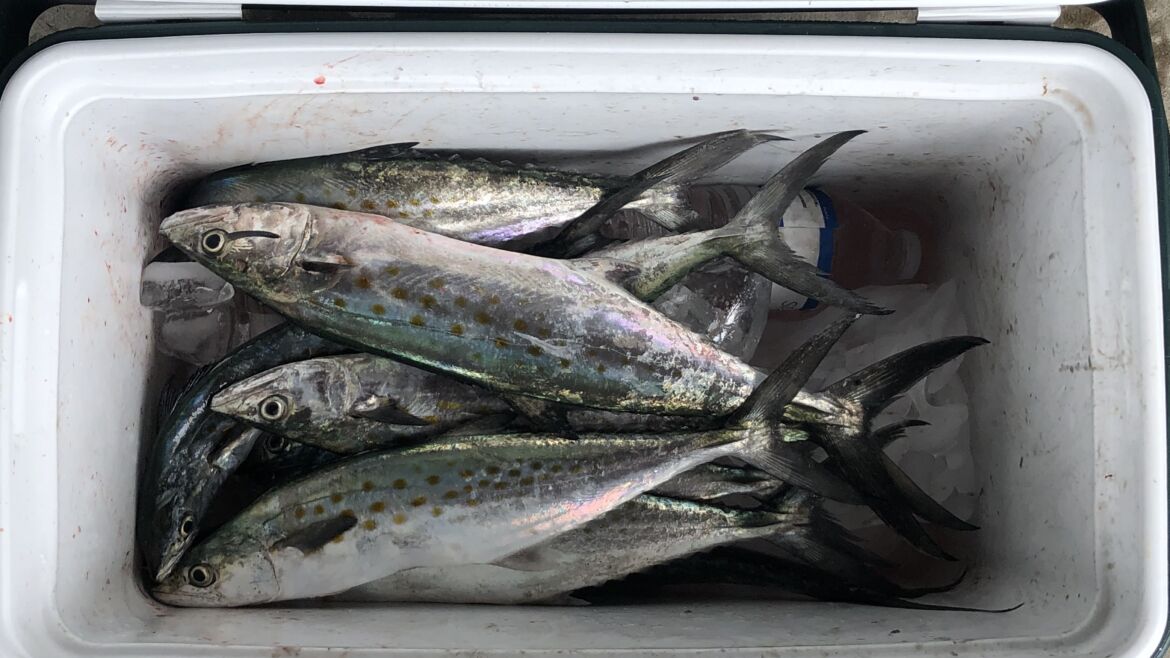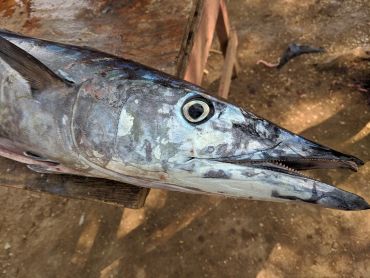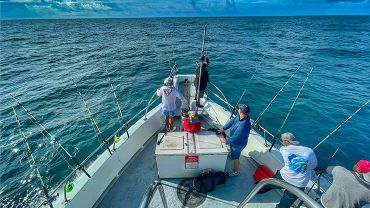The ability to catch and use live bait for saltwater fishing is an absolute game-changer. Don’t get me wrong, artificials are great, but when it comes down to it, a fish is almost always going to prefer a live bait in some capacity over an artificial. Now, I know this article is a little different from the ones I have written in the past, but I thought it was necessary to write as it gives anglers another way to set themselves apart and become the best they can be. Part of being a great fisherman is knowing how a fish is going to think in terms of things like where it would live or what it would like to eat. As a result, I wrote this article to help you guys catch the live bait needed to land those trophy fish, I know you’re after. For this article, I don’t plan on formatting it with different sections like the others; rather, I’m going to make a sub section for each type of saltwater live bait and describe how you can catch them, where you can find them, and some applications of how you could use that bait. In addition to this article, another helpful resource would be the Fishbox App. Now for the most part when catching live bait, you’re not going to be looking at a bite forecast like the one Fishbox provides; but the app still gives super helpful and relevant information on weather that you can plan your day around accordingly. So, take advantage of this resource and download the Fishbox app today. Let’s get into it!
Minnows
- Ballyhoo
- Where: Generally found in shallow waters near grass but can also be found above reefs and coral where there are lots of micronutrients around. I’ve even seen them in the canals of some beaches on the top of the water as well.
- How: There are multiple ways to catch them. Now obviously if they are piled up near the surface, I would go with a cast net. Sometimes, however, you may need to chum them up a little bit, especially if you are over a reef or some structure. A cast net will work just fine, but in these situations, a hoop net slowed pulled in behind them seems to be the most effective way.
- What: Ballyhoo are great offshore baits often enticing strikes from pelagics—especially mahi mahi.
- Menhaden/Pogy/Bunker
- Where: Pogies can generally be found near inlets or along the beaches on the East Coast. They are often seen in massive balls flicking their tails on the top of the water giving off a distinct popping sound.
- How: Use a large and heavy cast net. For myself, I typically use a ten-foot net. Oftentimes when trying to catch pogies, they’ll be a little bit deeper down, so you need the extra weight to get down on top of the fish quicker.
- What: These are great baits for just about everything in saltwater from king mackerel to flounder to grouper. This bait is not too hardy, but it will get eaten.
- Mullet
- Where: Mullet can be found almost anywhere in saltwater. The smaller ones are especially prevalent in the canals and the intercoastal waterway. At certain times of the year though, mullet will be scattered all over the beach ranging from as little as 3 inches to over a foot long. They are notorious for cruising on the top of the water in schools of about 30 or so but this does vary.
- How: Cast net is the preferred means of catching mullet. You don’t need a big one either—a 4–6-footer will suffice.
- What: Again, another super versatile bait that almost everything likes—especially redfish. Their size variation is awesome as it allows you to use them from inshore to offshore.
- Mud Minnows
- Where: Found in and around areas of thicker mud and shallow water.
- How: There are two ways of catching these guys. One, you can try and blind cast net for them because they don’t come to the surface like other types of minnows normally. Or two, the objectively better method which consists of using a trap baited with half of a blue crab. For whatever reason, the mud minnows love them, and you can very easily pull 30 of these guys from a trap with no problem.
- What: The perfect bait for flounder and redfish.
- Cigar Minnows
- Where: They normally hang around structures like buoys and posts offshore in somewhat deeper water.
- How: The preferred means of catching cigar minnows is with a sabiki rig. Pull up close to the structure and begin jigging the sabiki up and down and you should be able to catch a few for the well with a bit of patience.
- What: Great for king mackerel as well as other offshore applications where you are trolling dead baits. We “smoked” some red snapper with them this past summer (did you see what I did there?).
- Pilchards
- Where: Pilchards are almost always found in the shallow waters of bays and estuaries where they pile up in schools.
- How: The most effective means of catching them is with a cast net.
- What: Another great all-around bait—especially for offshore species when bottom fishing.
- Herring
- Where: Very similar to the cigar minnows, herring can also be found around structures like posts and buoys out at sea.
- How: Again, just like the cigar minnows, sabiki will be your best bet for catching this bait.
- What: Very similar application to cigar minnows and are a great all-around bait option.
- Sardines
- Where: They are generally found towards the top of the water column in select areas of the country. They are often schooling and migrate up and down the East Coast.
- How: Sardines can be caught using sabiki rigs or cast nets.
- What: Really good option for targeting tuna.
Read also: Your comprehensive guide to Red Snapper seasons
Shellfish
- Blue Crabs
- Where: In muddy or sandy bottoms in shallow water. Often found near grass buried under the mud until some kind of bait is presented.
- How: There are a ton of different ways to catch blue crabs. But I’m only going to detail the two most popular. The first means of catching these blue crabs is through baited traps or crab pots set out and left for a good period. This can be effective in the long run, but again, it takes time to get results with this method. The second method and the method I prefer is using a hand line baited with something like a chicken drumstick or a fish head. We will normally pull the boat up to a muddy area and set this handline in the water waiting for a crab to pull the line, so it is tight. At this point, we’ll swoop in with our net and catch the crab. Remember to follow local regulations.
- What: Great for black drum and red drum.
- Shrimp
- Where: Very similar habitat to crabs. Shrimp love sandy bottoms and can also be found in and around muddy areas with oysters.
- How: The easiest way to catch shrimp is either cast netting them while on a boat or on foot. Be careful not to cast the net on the oysters as they will destroy your net. Another important thing is to ask locals for their whereabouts. Yes, you can likely find shrimp almost anywhere in the water, but there are some spots where shrimp are more abundant than in others.
- What: Shrimp are good for literally anything—especially with regards to inshore species like speckled trout and red drum.
- Clams
- Where: Clams are generally found in mud buried beneath the surface.
- How: The easiest way to get clams is by using a rake and raking an area where there is a good bit of thick mud. You can find many areas like these on the side of the intercoastal waterway for example.
- What: Good for a lot of the smaller species like croakers, whiting, and pinfish.
- Fiddler Crabs
- Where: These guys are found all over the place but tend to congregate around grass. They burrow in little holes and retreat into them when threatened.
- How: You can either run up on these guys and try to catch them by hand (be careful not to get pinched) or you can use a net and drag it across the ground to catch them.
- What: Fiddler crabs work extremely well for species that crush their prey like black drum and sheepshead.
- Sand Fleas
- Where: These little guys are found all over the beach and can be primarily seen when the waves wash back over the sand, and they are scurrying back and burrowing into the sand.
- How: You can catch them with your hands, but it is far easier to catch them with a rake. As soon as the water starts to draw back after a wave has broken, stick the rake into the sand and pull towards the beach. Wash out your rake in the water and you should be left with some prime surf fishing bait.
- What: Sand fleas are an awesome option for permit fishing and a great all-around surf fishing bait.
- Squid
- Where: From what I’ve seen, squid inhabits a lot of the waters around where I fish be it in the ocean or even in the intercoastal.
- How: The only time I have ever been able to catch squid was when we were dragging a net behind the boat to catch shrimp in the waterway. We ended up catching about 100 squid which we froze to use for bait later on.
- What: Anything and everything will eat squid for bait. It can be a blessing and a curse. Just want your little kids to catch something—squid is your best friend. Trying to use squid to catch a flounder—squid is your worst nightmare simply because everything eats it.
Larger Baits
- Ribbonfish/Cutlassfish
- Where: From my experience, they are found in the ocean and in or around inlets with moving water.
- How: I’ve caught them as bycatch while trolling with Clarkspoons, but I’ve also caught them with spoons when they were schooling. I honestly don’t have much to say regarding targeting them, but you just gotta be in the right place at the right time – otherwise, you may have to buy them from the store to use them.
- What: An exceptional bait when fished on a downrigger for king mackerel. Other than that, I don’t know any other applications.
- Spanish Mackerel
- Where: Spanish mackerel can be found almost anywhere although they are most common in or around inlets or nearshore from about 20 to 40 feet of water depending on where you are fishing.
- How: Trolling and casting spoons are the easiest and most efficient way of catching them.
- What: Great for king mackerel and sharks.
- Bluefish
- Where: Bluefish generally inhabit the same areas as the Spanish and mostly congregate in and around inlets or nearshore in that same 20-40 foot water range.
- How: Trolling for them and casting spoons on busting blues is also an effective method of catching them. Additionally, you can catch them using cut bait on some sort of bottom rig.
- What: Bluefish are like spanish and are a good option to live bait fish with for king mackerel or even use for sharks.
- Pinfish
- Where: I say this jokingly, but it is pretty much true: you can find pinfish almost everywhere there is saltwater. I mean come on; they are perpetually stealing your bait wherever you go.
- How: Sabikis are a very effective means of catching multiple at a time. Sometimes tipping the sabikis with squid or other bait can be helpful. There are also pinfish traps you can use.
- What: Pinfish are an exceptional option for bigger bottom fish like snapper and groupers. They are very hardy and can take a beating.
- Bonito
- Where: Bonito are generally found within 3 miles of the beach and can be found busting on the top while feeding on glass minnows.
- How: The most effective means of catching them is by ripping casting spoons into the frenzy. You can also troll for these guys, but generally, the boat tends to scare the Bonito under the surface.
- What: Good for large pelagics like marlin and decent for shark bait. The problem is just keeping these guys alive.
- Blue Runner
- Where: Mostly found around reefs, wrecks and other structures in deeper water.
- How: The best way of catching them is probably using just hook and line with squid, shrimp, or other cut bait on the hook.
- What: Very similar applications to the pinfish. Really good bait for bottom fishing for bigger fish like groupers, snapper, and jacks.
- Stingray
- Where: Can be found virtually anywhere in shallow water whether it be in the intercoastal or on the beach.
- How: Using squid, shrimp, or some kind of minnow on a bottom rig you can normally convince one to bite with only a little difficulty.
- What: Hands down the best bait you can find for sharks of all species.
Get your personalized fishing map
Answer a quick quiz and get your own personalized fishing map
Conclusion
I hope you guys enjoyed this article and found it helpful. Now, next time you go saltwater fishing, hopefully you have some new ideas on what you can do given that you know more about how and where to catch various types of live bait as well as some of the more popular applications of that specific live bait. If I didn’t cover a certain type of live bait that you would like to see covered, please don’t be afraid to comment on the article and let me know. I would be more than happy to answer your questions and help you out. As always, good luck and tight lines!


